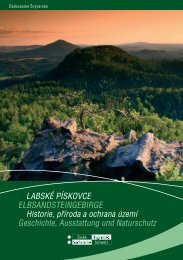ABSTRACT BOOK Sandstone Landscapes ... - Sandstones.org
ABSTRACT BOOK Sandstone Landscapes ... - Sandstones.org
ABSTRACT BOOK Sandstone Landscapes ... - Sandstones.org
You also want an ePaper? Increase the reach of your titles
YUMPU automatically turns print PDFs into web optimized ePapers that Google loves.
Yves KrippelResearch associate of the Natural History Museum Luxembourg, Enneschte Wee, 1A, L-7721 Colmar-Berg,Luxembourg (yves.krippel@mnhn.lu)The 'Petite Suisse' sandstone area in Luxembourg, a region of outstanding biodiversityThe conspicuous outcrops of Jurassic sandstone in the eastern part of the Grand-Duchy of Luxembourgoffer life conditions for an outstanding biodiversity. The region, known under the name of 'Petite Suisseluxembourgeoise' is characterised by a great concentration of natural, cultural and historical treasures. Thetypical relief is formed by large plateaus, cliffs, more or less steep scree-covered slopes and wet valleys.The extended beach forests which occupy the great majority of the slopes, can be characterised as 'ancient'woods. The sandstone formations and the dense canopy cover are responsible for a special microclimatewith high humidity and buffered temperatures. This conditions, as well as the multiplicity of habitatscontribute to an extraordinary biodiversity. Vertical rock faces of deep and often narrow crevices are evencharacterised by exceptional microclimatic conditions which tend to mimic the oceanic climate of theEuropean Atlantic fringe and offer therefore life conditions for a great number of rare species.The 'Petite Suisse' sandstone area is internationally known for the relictual populations of Tunbridge filmyfern(Hymenophyllum tunbrigense), first discovered in this continental island in 1821. It was therefore nota surprise that the gametophyte of another filmy fern, the Killarney fern (Trichomanes speciosum) was firstdiscovered for continental Europe in the same region in 1993. Apart from pteridophytes, the 'Petite Suisse'area is considered being one of the 50 th most important regions of bryological interest in Europe. On afaunistic point of view, the caves offer, for example, quarters for almost all bat species known inLuxembourg. On a prehistoric viewpoint, the region is well known for its Mesolithic past and it is notsurprising that the oldest skeleton ever found in Luxembourg, the so called 'Loschbur Man' was discoveredin this area.Since the 19 th century, tourism has played a major role in the economic development of this region and overthe years, the stunning scenery of the woods and sandstone outcrops has led to the creation of an extensivenetwork of public footpaths which exploit almost every corner of the forest and include most of theoutstanding rock formations. Many outdoor activities cause pressures which are no longer tolerable in sitesof extraordinary natural value. So efforts have to be made to conserve the beauty and integrity of thelandscape and to protect species from whom it is assumed that their isolated inland occurrences within theEuropean continent are a testimony to the once wider distribution earlier in this interglacial.T




